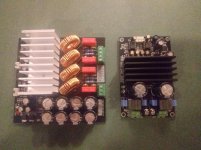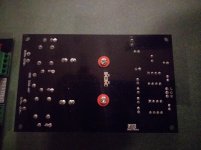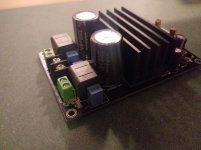I agree with that even though I would say it's definitely hifi, if not at the top of the ladder, so to speak. Without a doubt better than any commercial amp you can find for the cost of one board with connectors, psu and case.
After listening to it for a while now (stock, with 15kµf before the board, fed 30vdc), I find it fairly detailed, big sounding with really good tight bass. Dynamics are pretty good. It has a bit of graininess and upper midrange edge, vocals are ever so slightly veiled with what I'd like to describe as a pixelated tail to the sound (far from as bad as I've experienced with some tpa3116 amps, though), and I share Denbret's observations about the soundstage, it pretty much lives on the same plane as the speakers. Imaging is good and really solid though! Comparing it mainly to a Folsom tda7297 and a vintage Luxman LV-103, which are my other amps in heavy rotation. Speakers are cheap infinity stand mounts and Klipsch KG4.2 with Crites upgrades and bracing.
I'm looking forward to making the aforementioned changes to the board and maybe feeding it some more power. What's the gain of this board, btw?
And in regards to changing the 2200µf caps, is there a preferred choice? What am I looking for in a cap here?
I shure would love to hear the DrMordor or Jlester some time! Maybe when money isn't so tight...
After listening to it for a while now (stock, with 15kµf before the board, fed 30vdc), I find it fairly detailed, big sounding with really good tight bass. Dynamics are pretty good. It has a bit of graininess and upper midrange edge, vocals are ever so slightly veiled with what I'd like to describe as a pixelated tail to the sound (far from as bad as I've experienced with some tpa3116 amps, though), and I share Denbret's observations about the soundstage, it pretty much lives on the same plane as the speakers. Imaging is good and really solid though! Comparing it mainly to a Folsom tda7297 and a vintage Luxman LV-103, which are my other amps in heavy rotation. Speakers are cheap infinity stand mounts and Klipsch KG4.2 with Crites upgrades and bracing.
I'm looking forward to making the aforementioned changes to the board and maybe feeding it some more power. What's the gain of this board, btw?
And in regards to changing the 2200µf caps, is there a preferred choice? What am I looking for in a cap here?
I shure would love to hear the DrMordor or Jlester some time! Maybe when money isn't so tight...
Ryssen, Hi, if you don't have the option to buy mid / high range amps, you can buy vintage Grundig amps for less money, rest assured they sound great when paired with their speakers.
I bought the latest D class from drMordor (Akita), I can guarantee it sounds like a high end AB class, I drove the Tannoy Berkeley and the Gbl L112 very well.
The convenience of swapping op-amps makes this amp to your liking.
I bought the latest D class from drMordor (Akita), I can guarantee it sounds like a high end AB class, I drove the Tannoy Berkeley and the Gbl L112 very well.
The convenience of swapping op-amps makes this amp to your liking.
SMPS It should be...I accedently bought a 10A/30v SMTP do you think I will benefit much by going to 36v or even 42V?
This amp is HIFI, especially after the change of 2 large condos and change of OPs. I would say it's mid-range HIFI. Definitely better than the TPA3116. My 3255 here is in my workshop and it sounds very correct. for the price of parts and modifications, we have a fairly musical amp.
But if you are looking for higher sound quality, go your way and buy another better quality TPA325X.
But if you are looking for higher sound quality, go your way and buy another better quality TPA325X.
What really bothers me ... is the protection of the card ....
Impossible to exploit it fully.
I do not have this problem with the AKITA card ....
The sound is good ... but do not dream these cards are overrated in terms of power ...
But as said above, It is a leap forward compared to tpa 3116.
Impossible to exploit it fully.
I do not have this problem with the AKITA card ....
The sound is good ... but do not dream these cards are overrated in terms of power ...
But as said above, It is a leap forward compared to tpa 3116.
Last edited:
Battery Powered?
Hi I have one of these amps on the way (with the LME49720NA). I am planning on using it to upgrade the old 3116 on my camping boombox. I have a spare 10S-2P scooter battery that will push from ~40V down to about 33V at cutoff. Its about 5.5Ah and should deliver plenty of amperage all the way down to cutoff since each of the cells are rated for over 7A continuous (x2). Each channel has 1 tweeter and 1 woofer running through an x-over, resulting in an 8 Ohm load. RMS rating for the woofer and tweeter are each listed at 60W, respectively.
Sensitivity aside, does this amp/battery combo should like a good recipe to get the most out of my setup? Too much power? Too little?
Hi I have one of these amps on the way (with the LME49720NA). I am planning on using it to upgrade the old 3116 on my camping boombox. I have a spare 10S-2P scooter battery that will push from ~40V down to about 33V at cutoff. Its about 5.5Ah and should deliver plenty of amperage all the way down to cutoff since each of the cells are rated for over 7A continuous (x2). Each channel has 1 tweeter and 1 woofer running through an x-over, resulting in an 8 Ohm load. RMS rating for the woofer and tweeter are each listed at 60W, respectively.
Sensitivity aside, does this amp/battery combo should like a good recipe to get the most out of my setup? Too much power? Too little?
HI , for all of those of you worried about using an SMPS and large capacitors : there is an easy and relatively cheap way to `" softstart " any capacitor no matter how big it is.
Connect a 24 volt relay rated for 10 amps from the SMPS to the capacitor then bridge the contacts with a 10 ohm / 5w resistor . This limits the inicial current to 5 amps or less depending on voltage , and a Zener Diode with a 1 amp transistor in series with the relays coil to adapt it to the the actually used voltage , feedind´g the relay directly off the large cap.
This way the Cap is only connected direct to the SMPS once charged. And it keeps the SMPS from being forced.
Connect a 24 volt relay rated for 10 amps from the SMPS to the capacitor then bridge the contacts with a 10 ohm / 5w resistor . This limits the inicial current to 5 amps or less depending on voltage , and a Zener Diode with a 1 amp transistor in series with the relays coil to adapt it to the the actually used voltage , feedind´g the relay directly off the large cap.
This way the Cap is only connected direct to the SMPS once charged. And it keeps the SMPS from being forced.
Last edited:
Some scheme sketch ...HI , there is an easy and relatively cheap way to `" softstart " any capacitor no matter how big it is...

That's true. Hardware volume control provides a secondary protection against unforeseen volume surges.
I am playing with various volume control schemes for fun. One of them is the typical volume pot. I implemented mine with a 10k linear pot, and surprisingly it worked out pretty well.
I also implemented a discrete volume control using jumper caps. It had 4 possible volume levels. I believe it could be similar to a scheme mentioned by Claude, but cannot be sure. It also worked out well. Here is the drawing:
Im trying to come up with a discrete volume control like that myself. I wanted to do three different levels which would control the master volume in a dsp with fine tuning within each level to follow via bluetooth. I wanted to use three toggle switches. Coming up with a reasonably simple scheme that brings the 3.3v the dsp sends to the volume control from 0v (all switches down), 0.075v (one switch up), 1.0v (two switches cup) and 3v (all switches up) has been more difficult than I thought without spending some money on a circuit simulator.
It definitely has been done a million times, does anyone have a good example?
Im trying to come up with a discrete volume control like that myself. I wanted to do three different levels which would control the master volume in a dsp with fine tuning within each level to follow via bluetooth. I wanted to use three toggle switches. Coming up with a reasonably simple scheme that brings the 3.3v the dsp sends to the volume control from 0v (all switches down), 0.075v (one switch up), 1.0v (two switches cup) and 3v (all switches up) has been more difficult than I thought without spending some money on a circuit simulator.
It definitely has been done a million times, does anyone have a good example?
For me the discrete volume control was for fun and experimentation. For actual usage I still use the good old volume pot.
Yes, but I like the tactic feeling of toggle switches. My current system is Google Audio ChromeCast > Rega DAC > Naim Nait 5i > EB acoustics EB1 and I barely move the volume control of the Naim at all. So my aim was:
1: Chill (normal, one led)
2: Groove (two leds, nice)
3: Party (three leds, not sustainable without loss of hearing)
and mapping the volume control signal in the DSP from four distinct voltages accordingly.
1: Chill (normal, one led)
2: Groove (two leds, nice)
3: Party (three leds, not sustainable without loss of hearing)
and mapping the volume control signal in the DSP from four distinct voltages accordingly.
Last edited:
Would a breadboard allow you to experiment with various resistors to arrive at the sound levels you like?Yes, but I like the tactic feeling of toggle switches. My current system is Google Audio ChromeCast > Rega DAC > Naim Nait 5i > EB acoustics EB1 and I barely move the volume control of the Naim at all. So my aim was:
1: Chill (normal, one led)
2: Groove (two leds, nice)
3: Party (three leds, not sustainable without loss of hearing)
and mapping the volume control signal in the DSP from four distinct voltages accordingly.
I just tried 3 Shui Yuan modules with RSP-320-48 set to 37-38V. All have scary loud pop, when signal is turned on for the first time after power-on. It does not have pops on power-on or power-off.
Aliexpress seller recommended to put a switch to the Mute/Reset pins. It significantly reduces pop, but then there is another switch required.
Aliexpress seller recommended to put a switch to the Mute/Reset pins. It significantly reduces pop, but then there is another switch required.
- Home
- Amplifiers
- Class D
- Shui Yuan Audio TPA3255 Modification Thread



